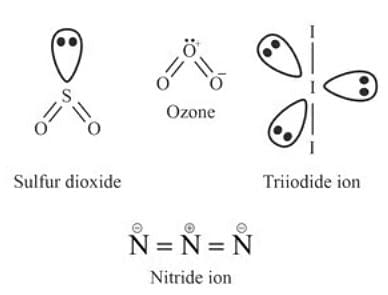The number of bent-shaped molecule(s) from the following is_______?
SO2, O3, I3-, N3-
SO2, O3, I3-, N3-
Solution and Explanation
1. SO2 (Sulfur Dioxide):
SO2 has a bent molecular geometry due to the lone pair of electrons on the sulfur atom, which causes electron pair repulsion and distorts the shape.
2. O3 (Ozone):
O3 has a central oxygen atom surrounded by one lone pair and three bonding electrons. This results in a bent molecular geometry, as the lone pair causes distortion in the structure.
3. I3- (Triiodide Ion):
I3- has a linear geometry. The central iodine atom has three lone pairs, and the bonding electrons are delocalized, maintaining a linear structure.
4. N3- (Azide Ion):
N3- is a linear molecule, as it consists of a chain of three nitrogen atoms connected by alternating double and single bonds, with delocalization of electrons across the structure.
Conclusion:
- Bent: SO2, O3
- Linear: I3-, N3-

So, Two molecules/ions, SO2 and O3, have a bent shape. The other two, I3- and N3-, have a linear form.
Top Questions on coordination compounds
- Calculate the empirical formula of a compound containing 40% carbon, 6.7% hydrogen, and 53.3% oxygen by mass.
- BITSAT - 2025
- Chemistry
- coordination compounds
- PCl$_3$, 2KCl does not give precipitate of AgCl with AgNO$_3$ solution. Write the structural formula and IUPAC name of the complex.
- CBSE CLASS XII - 2025
- Chemistry
- coordination compounds
- The IUPAC name of complex compound [Co(NH$_3$)$_6$]Cl$_3$ is
- Bihar Board XII - 2025
- Chemistry
- coordination compounds
- Which of the following compounds can be coloured?
- Bihar Board XII - 2025
- Chemistry
- coordination compounds
- Match each complex to its geometry:

- AIIMS Paramedical - 2025
- Chemistry
- coordination compounds
Questions Asked in JEE Main exam
- Ice at \( -5^\circ C \) is heated to become vapor with temperature of \( 110^\circ C \) at atmospheric pressure. The entropy change associated with this process can be obtained from:
- JEE Main - 2025
- Thermodynamics
- Let C be the circle of minimum area enclosing the ellipse E: \( \frac{x^2}{a^2} + \frac{y^2}{b^2} = 1 \) with eccentricity \( \frac{1}{2} \) and foci \( (\pm 2, 0) \). Let PQR be a variable triangle, whose vertex P is on the circle C and the side QR of length 29 is parallel to the major axis and contains the point of intersection of E with the negative y-axis. Then the maximum area of the triangle PQR is:
- JEE Main - 2025
- Coordinate Geometry
- Let circle $C$ be the image of
$$ x^2 + y^2 - 2x + 4y - 4 = 0 $$
in the line
$$ 2x - 3y + 5 = 0 $$
and $A$ be the point on $C$ such that $OA$ is parallel to the x-axis and $A$ lies on the right-hand side of the centre $O$ of $C$.
If $B(\alpha, \beta)$, with $\beta < 4$, lies on $C$ such that the length of the arc $AB$ is $\frac{1}{6}$ of the perimeter of $C$, then $\beta - \sqrt{3}\alpha$ is equal to: 0.01 mole of an organic compound (X) containing 10% hydrogen, on complete combustion, produced 0.9 g H₂O. Molar mass of (X) is ___________g mol\(^{-1}\).
- JEE Main - 2025
- Organic Chemistry
- In the Claisen-Schmidt reaction to prepare dibenzalacetone from 5.3 g benzaldehyde, a total of 3.51 g of product was obtained. The percentage yield in this reaction was _____.
- JEE Main - 2025
- Reaction Mechanisms & Synthesis
Concepts Used:
Coordination Compounds
A coordination compound holds a central metal atom or ion surrounded by various oppositely charged ions or neutral molecules. These molecules or ions are re-bonded to the metal atom or ion by a coordinate bond.
Coordination entity:
A coordination entity composes of a central metal atom or ion bonded to a fixed number of ions or molecules.
Ligands:
A molecule, ion, or group which is bonded to the metal atom or ion in a complex or coordination compound by a coordinate bond is commonly called a ligand. It may be either neutral, positively, or negatively charged.